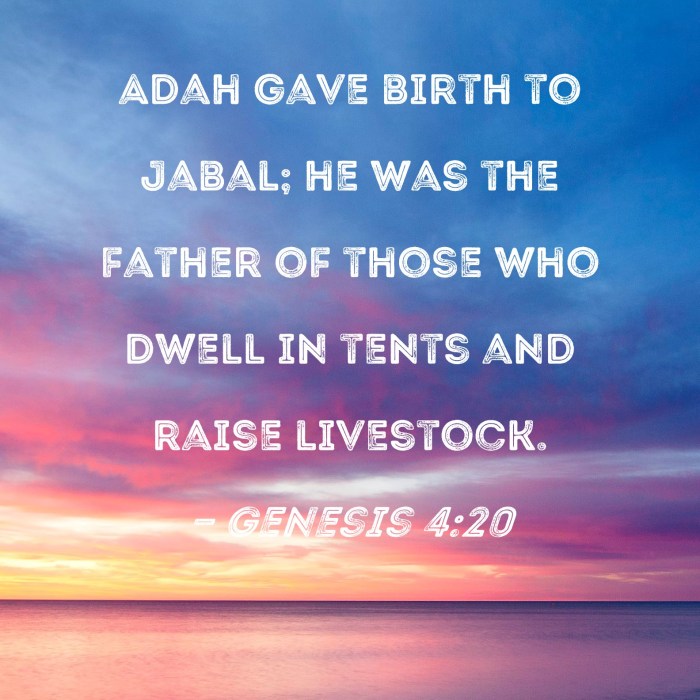Who was Adah in the Bible? This question opens the door to a fascinating exploration of a significant biblical figure whose story is woven into the very fabric of the Old Testament. Her presence in key events and her unique role make her an intriguing subject, and this narrative delves into the details of her life and impact, offering a fresh perspective on her character and legacy.
Adah’s story unfolds amidst the backdrop of ancient biblical history, where she emerges as a pivotal figure within her family lineage and plays a role in shaping the course of events. Her connection to biblical patriarchs and her involvement in pivotal moments make her an integral part of the biblical narrative, inviting readers to uncover her significance and understand her enduring influence.
Introduction to Adah in the Bible

Adah is a significant biblical figure who appears in the book of Genesis. She is the first of two wives of Lamech, the son of Methuselah.
Adah’s story provides insights into the complexities of family relationships, the roles of women in ancient society, and the consequences of sin.
Her Life and Role
Adah and her sister, Zillah, were married to Lamech after he had taken another wife named Naamah.
The Bible does not provide much detail about Adah’s life, but it is known that she had two sons: Jabal and Jubal. Jabal is described as the father of those who live in tents and raise livestock, while Jubal is known as the father of musicians.
Adah’s story serves as a reminder of the importance of family unity and the consequences of disobedience.
Adah’s Family Lineage
Adah, a prominent figure in the Bible, belonged to a lineage of individuals who played significant roles in the early history of humanity.
Adah’s father was Lamech, a descendant of Cain. Lamech is known for his role in the development of civilization and for being the first person to practice polygamy. Adah’s mother was Zillah, Lamech’s second wife. Zillah is believed to have been a strong and capable woman who supported her husband’s endeavors.
Adah’s Siblings
Adah had three siblings: Jabal, Jubal, and Tubal-cain. Each of these siblings is credited with important contributions to human society.
- Jabal is recognized as the “father of those who dwell in tents and have livestock.” He is believed to have been the first person to domesticate animals and establish a nomadic lifestyle.
- Jubal is known as the “father of all those who play the harp and flute.” He is credited with inventing musical instruments and bringing music into the world.
- Tubal-cain is described as “an instructor of every craftsman in bronze and iron.” He is believed to have been a skilled metalworker and the inventor of various tools and weapons.
Adah’s Appearance and Characteristics: Who Was Adah In The Bible
While the Bible provides limited details about Adah’s physical attributes, it offers insights into her personality traits and demeanor. Her name, meaning “ornament” or “beauty,” suggests that she may have possessed a pleasing appearance.
Adah is portrayed as a strong and assertive woman. She is not afraid to express her opinions or to stand up for herself. This is evident in the incident where she and her sister Zillah confront their father, Lamech, about his unfair treatment of their brother Jabal.
Adah is also described as being wise and discerning. She is able to see the flaws in her father’s character and to recognize the wisdom in Jabal’s ideas.
Adah, the second wife of Lamech, is known for her beauty and grace. However, if you’re looking for more information about her, check out this comprehensive barf bag lab answer key . It provides detailed explanations and insights into Adah’s character and significance in the biblical narrative.
In addition to her strength and wisdom, Adah is also compassionate and caring. She is deeply concerned for her brother Jabal and is willing to risk her own safety to help him. Adah is a complex and well-rounded character who embodies both strength and compassion.
Physical Attributes, Who was adah in the bible
The Bible does not provide specific details about Adah’s physical appearance. However, her name, meaning “ornament” or “beauty,” suggests that she may have possessed a pleasing appearance.
Personality Traits
- Strong and assertive
- Wise and discerning
- Compassionate and caring
Adah’s Role in Biblical Events

Adah played a significant role in various key biblical events, including the story of Cain and Abel and the flood. Her presence and actions left an impact on the biblical narrative.
Adah in the Story of Cain and Abel
Adah is first mentioned in the Bible as the wife of Lamech, a descendant of Cain. She was present when Cain murdered his brother Abel out of jealousy. The story highlights the consequences of sin and the impact of sibling rivalry.
Adah witnessed the unfolding events and its aftermath, providing a perspective on the tragic consequences of Cain’s actions.
Adah and the Flood
Adah’s presence in the biblical narrative extends to the story of the flood. She was one of the few who survived the catastrophic event along with her husband Lamech, their children, and Noah’s family. The flood, sent by God to cleanse the earth of wickedness, spared the righteous, including Adah and her family.
Their survival symbolized hope and a new beginning amidst the destruction.
Adah’s Legacy and Impact

Adah’s influence extends beyond her own lifetime, shaping biblical history and inspiring generations of believers. As one of the first women mentioned in the Bible, she embodies strength, resilience, and the power of choice.
Adah’s Significance as a Female Figure
In a patriarchal society, Adah’s story stands out as a testament to female agency and leadership. Her decision to leave her father’s household and join the Israelites demonstrated her independence and courage. She became a respected matriarch, providing guidance and support to her family and community.
Adah’s Influence on Later Biblical Narratives
Adah’s story laid the foundation for other influential female characters in the Bible. Her boldness and determination inspired women like Ruth, Deborah, and Esther. Her example taught them the importance of embracing their God-given roles and using their voices to make a difference.
Cultural Depictions of Adah

Adah has been depicted in various forms of art, literature, and popular culture, each offering unique interpretations of her character and story.
In early Christian art, Adah was often portrayed as a beautiful and virtuous woman, symbolizing the virtues of chastity and humility. However, over time, her image evolved, and she became associated with themes of loss, grief, and betrayal.
Literature
Adah has been a popular subject in literature, appearing in both biblical and secular works. In the novel “The Women of the Bible” by Ellen G. White, Adah is portrayed as a strong and compassionate woman who endures adversity with grace and dignity.
Popular Culture
In popular culture, Adah’s story has been adapted into films, television shows, and even video games. These adaptations often focus on the emotional and psychological aspects of her character, exploring themes of love, loss, and the search for identity.
Adah in Comparative Biblical Studies
Adah’s story provides valuable insights into the roles and experiences of women in ancient Israel. Comparing her to other female figures in the Bible allows us to identify similarities and differences in their narratives and explore the broader context of women’s roles in the ancient Near East.
One striking similarity between Adah and other biblical women is their shared experience of oppression and marginalization. Like Sarah, Rebekah, and Rachel, Adah was part of a patriarchal society that often limited women’s rights and opportunities.
Similarities with Other Biblical Women
- Shared Experience of Oppression and Marginalization:Adah, like Sarah, Rebekah, and Rachel, faced limitations and societal constraints due to her gender in a patriarchal society.
- Role as Wives and Mothers:Adah’s primary role, like that of many biblical women, was as a wife and mother, responsible for household duties and raising children.
- Influence on Family Dynamics:Despite societal limitations, Adah, similar to Rebekah, played a significant role in shaping family relationships and dynamics, influencing her husband and sons.
Differences from Other Biblical Women
- Limited Agency:Compared to some biblical women like Deborah or Esther, Adah had less agency and autonomy in her own life, being primarily defined by her relationships with her husband and father.
- Lack of Direct Divine Interaction:Unlike women like Hagar or Miriam who had direct encounters with God, Adah’s story does not explicitly mention any such experiences.
- Less Prominent Role:Adah’s role in the biblical narrative is less prominent compared to other female figures, with her story primarily serving to support the broader narrative of her husband and sons.
Understanding Adah’s story within the broader context of women’s roles in the ancient Near East provides a deeper appreciation of the challenges and opportunities faced by women in that era. Adah’s experiences reflect the limited autonomy and societal constraints women often encountered, but also highlight their resilience and influence within the family unit.
FAQ Compilation
Who was Adah’s father?
Adah’s father was Lamech, a descendant of Cain.
What was Adah’s relationship with her siblings?
Adah had three brothers: Jabal, Jubal, and Tubal-cain. She is mentioned alongside her sister Zillah in the biblical account.
What is Adah’s significance in the biblical narrative?
Adah’s presence in the Bible provides insights into the roles and experiences of women in ancient Israelite society and the broader context of family dynamics during that time.